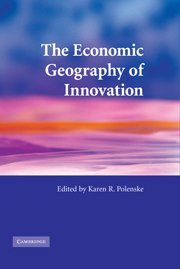Book contents
- Frontmatter
- Contents
- List of figures
- List of tables
- Notes on contributors
- Acknowledgments
- Abstracts
- List of abbreviations and acronyms
- Part I Concepts and measurements in innovation
- 1 Introduction
- 2 Measurement of the clustering and dispersion of innovation
- 3 Measuring the geography of innovation: a literature review
- 4 Employment growth and clusters dynamics of creative industries in Great Britain
- Part II Institutional and spatial aspects of information and knowledge flows
- Part III Institutions and innovation systems
- Index
- References
4 - Employment growth and clusters dynamics of creative industries in Great Britain
Published online by Cambridge University Press: 22 September 2009
- Frontmatter
- Contents
- List of figures
- List of tables
- Notes on contributors
- Acknowledgments
- Abstracts
- List of abbreviations and acronyms
- Part I Concepts and measurements in innovation
- 1 Introduction
- 2 Measurement of the clustering and dispersion of innovation
- 3 Measuring the geography of innovation: a literature review
- 4 Employment growth and clusters dynamics of creative industries in Great Britain
- Part II Institutional and spatial aspects of information and knowledge flows
- Part III Institutions and innovation systems
- Index
- References
Summary
Introduction
The definition of creative industries has been outlined by Britain's Creative Task Force as “those activities which have their origin in individual creativity, skill and talent, and which have the potential for wealth and job creation through the generation and exploitation of intellectual property” (Department for Culture, Media and Sport – DCMS 2001)
Creative industries have been identified as contributing to over 5 percent of GDP (DCMS 2001). A selection of some of these industries, for which data are available, generates £112.5 billion a year in revenues, of which £10.3 billion is through exports. Output growth in this set between 1997 and 1998 was a strong 16 percent, compared to 6 percent for the economy as a whole (Freeman 2002).
These industries are likely to be characterized by differentiated products, niche markets, vertical disintegration, and consumer externalities. Location also has the potential to act as a brand or image. It is estimated that 50 percent of all employees in the sector are clustered in London and in the South East of England. In addition, an important share of these jobs is to be found in SMEs. Creative industries have in particular received a fresh wave of attention as “London's Core Business” (Freeman 2002). Between 1995 and 2000, they produced the second largest source of job growth, the second largest source of output, and were the third largest source of jobs in the city.
- Type
- Chapter
- Information
- The Economic Geography of Innovation , pp. 60 - 84Publisher: Cambridge University PressPrint publication year: 2007
References
- 5
- Cited by



